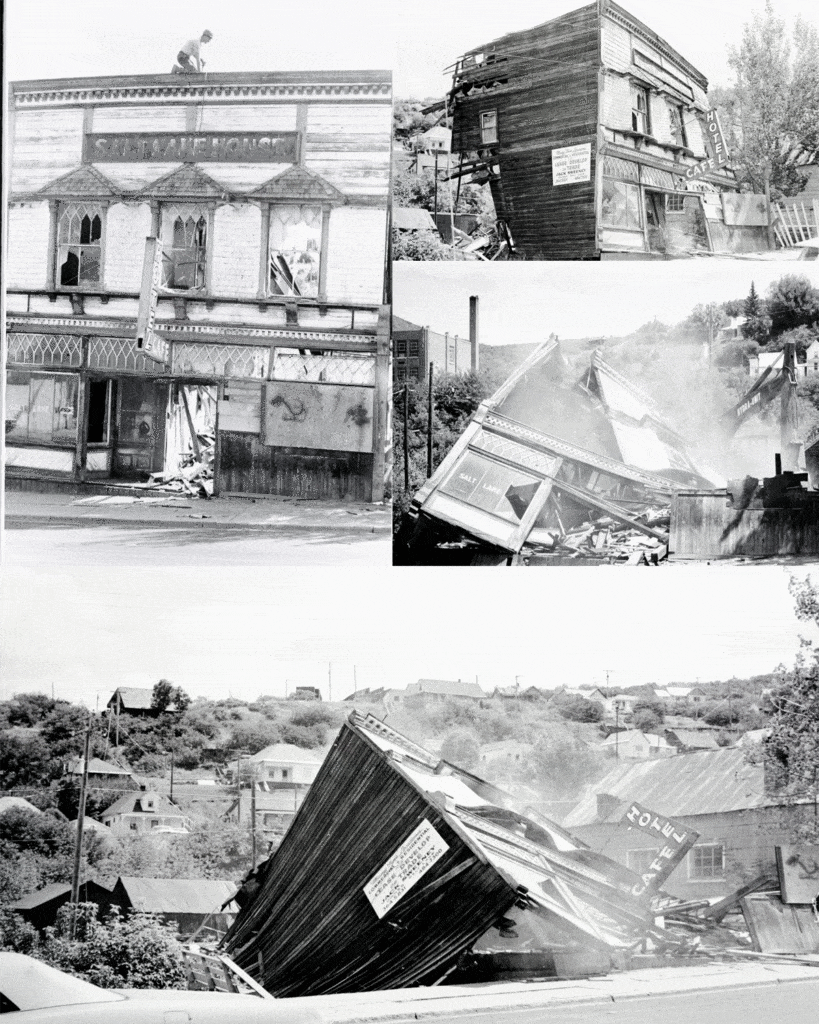There was a time when Park City wanted nothing to do with historic preservation.
During the 1950s and 1960s, when the price of silver plummeted and 1200 miners were put out of work, the once booming community nearly became a ghost town and the city struggled to survive. Hundreds of people left town, walking away from property that had become worthless. Some moved their houses with them. In 1953, 58 buildings on Main Street alone were torn down or abandoned.
There were suddenly scores of vacant and deteriorating houses. Miner’s cottages had not been built to last since most were erected in a matter of days for miners who planned to leave when they inevitably made their fortunes. This flimsy construction left them vulnerable to the ravages of severe weather; Vandals ransacked them for household goods left behind.
After a Park Record story about five families leaving town in one day, an anonymous writer scolded, “Don’t be ashamed of your town!” In an effort to remedy the “unsightly conditions,” demolition efforts began. A new Progressive Club’s first project was to tear down vacant buildings. After they were dismantled, the rubble was usually burned. The Park Record noted that, “Although the smoke was unpleasant for the neighbors, they were happy to see the dilapidated buildings go before an unscheduled fire was started or before some child was hurt ‘treasure hunting’ the ghost homes.” A 1957 ad to re-elect the mayor touted that he was “successful in obtaining permission to remove many of the dilapidated structures of this city.” In a desperate attempt to attract business, a sign was erected along Highway 40 saying, “Visit Park City – Historic Mining Camp.“ Many said the sign would do no good when people would come and see such a shabby town.
The Park Record stated that “What’s going to happen to Park City?” is the leading topic of conversation in town. It also prophetically re-printed an article from the Wall Street Journal that told of former mining camps turning into tourist attractions.
One structure the town did agree to save was the beloved 1884 St. Mary’s Catholic Church. When it was severely damaged by fire in 1950, the congregation vowed to restore it.
The handful of remaining residents tried to modernize their outdated homes with trendy, mid-century modern fixes. They lowered ceilings and sprayed on acoustic “popcorn” ceilings. Fancy woodwork and front doors were tossed. Wooden plank floors were covered with popular linoleum or shag carpet. Plastic molding and Formica countertops were installed. Original double-hung front windows were often replaced with one enormous, rectangular “picture window.” One owner purloined a roadside diner’s Naugahyde booth and installed it in his kitchen. The resulting mish-mash of architectural styles eroded the historic integrity of almost every house.
Businesses also embraced modernization, replacing old signs with new and painting with popular bright colors. New owners updated the old Bucket Bar on Main Street, turning it into a hip discotheque, a term that needed to be explained to the locals.

Credit: Park City Historical Society & Museum, Bea Kummer Collection
The demolitions went on throughout the 1960s as the newly formed Chamber of Commerce requested that everyone continue to destroy the “ugly old buildings” and groups of citizens volunteered to supervise the burning of collapsed structures. The Salt Lake House, a “once lovely hotel” on Main Street was taken down along with four more houses. The Chamber sold tickets and raffled off two building lots on Woodside Avenue, promising homes on those lots would be razed first. City-owned historic buildings were left standing, but they fell into disrepair with the city unable to maintain them, let alone restore them.
In the late 1960s, as Treasure Mountains Resort became more established, new residential construction slowly began. A few A-frame ski cabins popped up between miner’s cottages close to the slopes, a stark glass house on Rossie Hill attracted media attention, and a cubistic vacation home by the resort became a curiosity. The school district erected a house with the latest split-level style in hopes of attracting a new superintendent. The design of the new construction radically contrasted with the rest of town, sparking controversy about architectural style that continues to this day.
During this time, a small visionary group of locals was studying how other historic towns like Williamsburg, Virginia, were attracting tourists. In discussing the possibility of Park City becoming a recreation center one day, they said it was imperative that Park City’s “attractive mining camp atmosphere be preserved.”
In the decades to come, Park City would embrace the preservation of its past, realizing that restoring historic buildings and showcasing the town’s unique history would create a magical setting for its rebirth as a resort destination. Its authenticity would enchant visitors, create a distinctive sense of place, and honor the town’s heritage. But it was no easy shift. Stay tuned for an article covering the 1970s, when local attitudes about preservation began to change.
Stay tuned for part two.